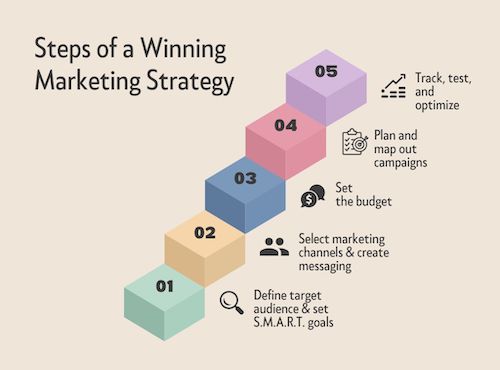
Many marketers will tell you the same thing: don’t try to grow your business without a solid marketing strategy.
Think of it as your business roadmap. It helps you identify your ideal audience, determine how to reach them, and outline the steps to get them interested in your offering. Without a clear plan, you risk wasting time and money on tactics that don’t work.
This guide walks you through how to create a winning marketing strategy step by step. You’ll find simple tips, real examples, and actionable advice to help you make smart choices that deliver results. We’ll also explore how digital marketing strategy fits into the mix, especially in today’s online-driven world.
Whether you run a small business or are just curious about how marketing works, this is a great place to begin.
What Is a Marketing Strategy?
A marketing strategy is the long-term roadmap your business uses to attract and retain customers. It goes beyond just running ads or posting on social media; it ties all your marketing efforts together into a cohesive plan.
A strong marketing strategy should help you answer questions like:
- Who are your ideal customers?
- What do they care about?
- How can your business meet their needs?
Your strategy outlines your goals, messaging, target audience, competitive advantage, and the channels – like email, content, or search engines – you’ll use to connect with people. It ensures that every marketing move, big or small, supports your larger goals.
It’s also important to distinguish between strategy and tactics. A tactic might be posting an Instagram Reel or running a Google Ads campaign. Your marketing strategy is the foundation those actions are built on. It gives your tactics purpose, so you’re not just “doing marketing.” You’re doing it with intention.
Digital marketing strategy is a key piece of this. While your overall strategy might include print ads or in-person events, your digital marketing strategy focuses on online efforts like SEO, social media, and email campaigns.
Why Your Business Needs a Solid Marketing Strategy
Having a clear go-to marketing strategy is essential for growth. A well-crafted strategy gives your business direction and focus, helping you reach the right people and achieve your goals.
Did you know? Marketers with a documented strategy are 414% more likely to report success, according to CoSchedule (2022). That’s double the number from just three years earlier, which is a compelling reason to put your strategy in writing.
Here’s how a strong marketing strategy helps:
- Clarity: Clearly defines your audience, messaging, and marketing channels so your team stays aligned.
- Better ROI: Helps you allocate time and resources toward what actually works.
- Effective targeting: Enables you to tailor messaging to your audience’s specific needs.
- Long-term vision: Keeps you focused on goals, not just short-term wins.
Key Elements of a Great Marketing Strategy
Every winning marketing strategy starts with a few key building blocks. Together, these elements create the foundation of an effective plan:
- Target Audience Definition: Know exactly who you want to reach. Build detailed buyer personas including demographics, behaviors, and pain points.
- Clear Business Goals: Align marketing goals with your broader business objectives. Focus on outcomes like lead generation, increased sales, or customer retention.
- Messaging and Positioning: Define your unique value proposition. What sets you apart? Use consistent messaging that clearly communicates why customers should choose you.
- Channel Selection: Choose the right mix of channels – online and offline – to meet your audience where they are (social media, search, email, etc.).
- Content Plan: Outline the types of content you’ll create (blogs, videos, case studies, emails) and how often you’ll publish.
- Budget Allocation: Decide how much you’ll invest in different campaigns. Your budget should support your goals and allow room for testing.
- Measurement and KPIs: Determine what success looks like. Use relevant KPIs to track performance and guide decision-making.

How to Build Your Marketing Strategy Step-by-Step
Ready to get started? Follow these seven simple steps to create your own marketing strategy:
- Define your target audience: Who are they? What are their pain points? What motivates them to buy?
- Set SMART marketing goals: Goals should be Specific, Measurable, Achievable, Relevant, and Time-bound.
- Choose your marketing channels: Focus on platforms where your audience spends time.
- Create messaging and brand assets: Build clear messaging and design consistent visuals that reflect your brand.
- Set a marketing budget: Decide how much to spend per channel or campaign, leaving room to experiment.
- Plan your campaigns: Create a calendar of promotions, launches, or events with clear timelines.
- Track, test, and optimize: Review your metrics, run A/B tests, and make adjustments based on what’s working.
Common Marketing Strategy Mistakes to Avoid
Even the best strategies can fall short if you overlook common pitfalls. Here’s what to watch out for:
- Being too vague or trying to be everywhere: Spreading efforts too thin reduces effectiveness. Focus on where your audience actually is.
- No clear KPIs or measurements: Without data, you’re guessing. Set clear metrics from the beginning.
- Failing to update the strategy: Markets change. Your strategy should evolve too.
- Ignoring digital trends: Skipping video, automation, or AI tools can limit your growth.
- Misaligned marketing and business goals: Don’t market just to stay busy—tie everything back to a business objective.
- Inconsistent branding or messaging: Mixed messages confuse your audience. Be consistent across every channel.
Final Thoughts: Your Strategy, Your Superpower
A great marketing strategy is more than a checklist. It’s your guide to building a sustainable, growth-focused business. We’ve covered what it is, why it matters, and exactly how to create one step by step.
But remember: your strategy isn’t static. Revisit it quarterly, refine your goals, and adjust to changes in your market.
Ready to start building a strategy that works?
Book a free demo of our marketing evaluation or contact us today for personalized support.

Comments